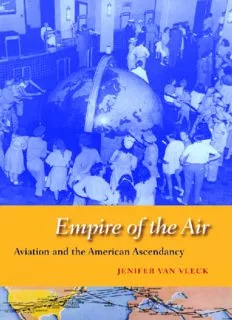
Empire of the Air: Aviation and the American Ascendancy PDF
Preview Empire of the Air: Aviation and the American Ascendancy
Empire of the Air Empire of the Air A V I AT I O N A N D T H E A M E R I C A N A S C E N D A N C Y Jenifer Van Vleck Cambridge, Massachusetts, and London, England 2013 Copyright © 2013 by the President and Fellows of Harvard College All rights reserved Printed in the United States of America Cataloging-in-Publication Data available from the Library of Congress. Library of Congress catalog card number: 2012051096 ISBN: 978-0-674-05094-5 For my parents, Richard and Caren Van Vleck Contents Introduction: The Logic of the Air 1 1 The Americanization of the Airplane 18 2 Good Neighbors Are Close Neighbors 53 3 Global Visions, National Interests 89 4 “America’s Lifeline to Africa” 131 5 From Open Door to Open Sky 167 6 Mass Air Travel and the Routes of the Cold War 199 7 The Jet Age and the Limits of American Power 239 Conclusion: “Empires Rise and Empires Fall” 281 Sources and Abbreviations 305 Notes 307 Ack now ledg ments 357 Index 361 Introduction: The Logic of the Air On any given day in the summer of 1939, thousands of Americans at Pan American Airways’ Dinner Key Terminal in Miami, Florida, were watch- ing the world turn. As newspaper headlines and newsreels warned of im- pending war in Eu rope, visitors gazed at a gigantic, rotating globe—o ne of the largest ever built in the United States, weighing 3.25 tons and mea- sur ing 10 feet in diameter— and refl ected on the state of the world. Per- haps they marveled at how modern communications and transportation technologies had seemed to shrink distance and time. Perhaps, in this context, they worried about the United States’ neutrality and national se- curity, as the expansionist ambitions of Nazi Germany and imperial Japan had once again brought the world to the brink of war. Or perhaps they were simply imagining distant lands that they would like to visit, once the U.S. economy (and their own bank accounts) fully recovered from the ravages of the Depression. But whate ver they w ere thinking or feeling, these thousands of Americans could perceive the world as within their reach, both literally and fi guratively.1 Built in 1933– 1934 by architects William Adams Delano and Chester Holmes Aldrich, who had previously earned their reputation designing estates and social clubs for families such as the Astors, Rocke fell ers, and
Description: